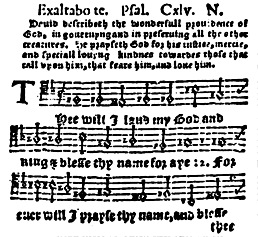
...I have caused a new print of note to be made with letter to be joined to every note: whereby thou mayest know how to call every note by his right name, so that with a very little diligence thou mayest more easilie by the viewing of these letters, come to the knowledge of perfect solfeying... the letters be these U for Ut, R for Re, M for My, F for Fa, S for Sol, L for La. Thus where you see any letter joyned by the notes you may easilie call him by his right name, ...

Shown above is an example of English solfege type - in the original the staff measures 7mm high. The syllables in the first line are Fa Fa Mi Fa Fa Fa Sol. Note on the bottom line the "V" for Vt [Ut], a remnant of the hexachord system.